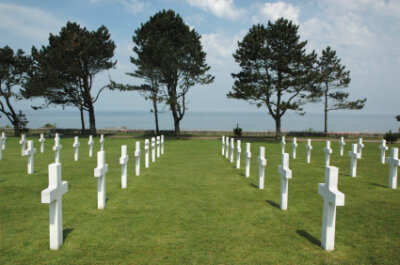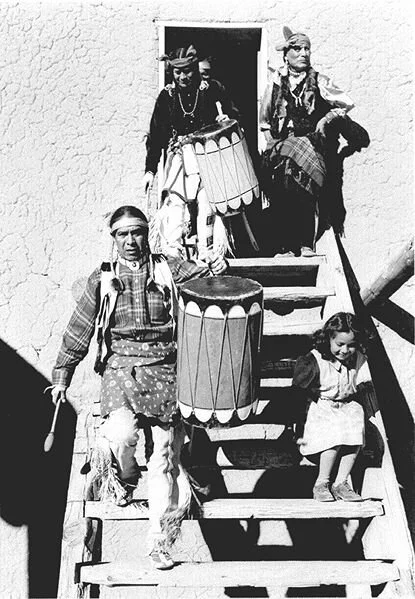Manzanar War Relocation Center was not on anyone's travel itinerary in 1942 when the United States government ordered 11,000 Japanese-Americans to leave their homes to be detained in internment camps. These days, visitors like writer Carolyn Handler Miller come to Manzanar National Historic Site to learn the stories of the people who were important to this place and experience a challenging mix of both injustice and beauty.
All tagged Historical travel
by Connie Hand
The sun was bright under a clear azure sky. The birds were merrily singing on that beautiful Summer morning. As I stood by the country road and stared at the house in front of me, my heart was pounding. I was in Nariz, Portugal standing in front of a house that was typical of the area. But this house was special to me because it was the one in which my father was born. Immediately I thought of the stories he used to tell about his childhood in Portugal and his journey to America.
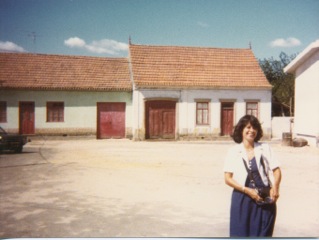
I always loved to hear about far away places and thought that one day I would travel to Portugal to visit those little towns and big cities that Dad talked about in such a vivid way.
The story of my father, Augusto Silva began on June 8, 1911 in Nariz in the district of Aveiro. He was the second of five children born to Maria and Luis Silva, and it was not an easy life. The family farmed their lands and tried to make ends meet. In 1927, Dad decided to emigrate to the United States, and it was a life-altering decision. He researched what was necessary for his journey. It must have been very hard on both of them when his widowed mother gave him her approval to leave. He told me he vowed to go back to visit this sweet woman, and he did keep that vow. He described that visit with tears in his eyes.
He traveled to Lisbon, the capital of Portugal, and worked there for several months until he discovered that Portugal’s emigration quotas were filled for the next several years. He was advised to travel to France to take up residency in Paris. He told me that he worked in Paris doing odd jobs. I remember Dad telling me that Paris was a huge, beautiful city. He said he saw as many sights as he could, but he really couldn’t wait to get to America.
by Silvia Pe
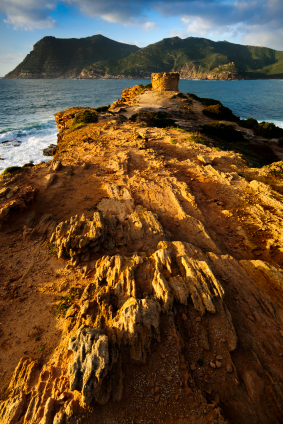 We were all children once. Childhood is the time of dreams and fantasies, when our imagination craves great adventures. I wonder if there’s a child who has never dreamt of becoming the king of an enchanted, beautiful castle? It was my dream when I was six.
We were all children once. Childhood is the time of dreams and fantasies, when our imagination craves great adventures. I wonder if there’s a child who has never dreamt of becoming the king of an enchanted, beautiful castle? It was my dream when I was six.
I grew up in Sardinia, listening to the legends of the proud guardians of the Sardinian coastline. My favourite locations were the coastal towers: They’re scattered along the edges of the whole island, from Cagliari to Alghero, from Oristano to Siniscola, placed to form a big protective circle. My Sardinian history teacher was my grandfather, an old fashioned sailor.
He was a charming middle-aged man. His broad shoulders and rather serious demeanor gave him an authoritarian look, but he had kind eyes. He loved to enchant me by gesturing with his knotty hands, telling me about the Sardinian silent watchers… Built to resist the pirate’s incursions, the towers were managed, equipped and defended by the Royal Tower Administration, a proto-agency based in Cagliari. A stone in Uras dating back to 1546 stands as a witness of one of the incursions by the infamous Red Beard, or Barbarossa as we call him (his real name being Khayr al-Din).
The towers were placed in a way that allowed the watchers to communicate using visuals and sounds, without leaving their stations… a little bit like when I was in front of my grandpa and my thoughts started running as if into a dream world.
Honoring America's Fallen Soldiers in Normandy
by Roy Stevenson
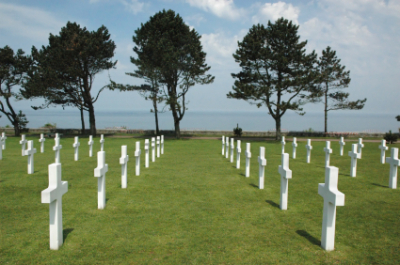 American Military Cemetery, Colleville, Normandy, FranceThe view from the top of the high, soft, sand dunes next to the American Military Cemetery at Colleville, Normandy, is great today. It’s a bright clear blue sky and I can see for miles. French fishing trawlers churn through the choppy, deep blue water, miles out to sea, leaving wide foaming wakes behind them. Gazing down across the long, deserted flat white expanse of Omaha Beach, I can see where the olive uniformed American soldiers debarked their landing craft, to shelter behind steel tetrahedrons, or sprint up the beach on D-Day, June 6, 1944.
American Military Cemetery, Colleville, Normandy, FranceThe view from the top of the high, soft, sand dunes next to the American Military Cemetery at Colleville, Normandy, is great today. It’s a bright clear blue sky and I can see for miles. French fishing trawlers churn through the choppy, deep blue water, miles out to sea, leaving wide foaming wakes behind them. Gazing down across the long, deserted flat white expanse of Omaha Beach, I can see where the olive uniformed American soldiers debarked their landing craft, to shelter behind steel tetrahedrons, or sprint up the beach on D-Day, June 6, 1944.
Descending the sand dunes, I walk the long 500 meters down the gently sloping beach to the water’s edge. It’s dead low tide. I turn around, looking back up towards the dunes. I’m amazed at how far away they are. They would seem like they were miles away, especially to a young soldier armed to the teeth and heavily weighed down with equipment.
It must have been terrifying trying to sprint up the beach into the teeth of a hailstorm of machine gun, rifle, and mortar fire. Of the soldiers in the first few D-Day landing craft, 90% didn’t even make it up the beach. In my mind’s eye I fleetingly see chaos, patches of red blood-drenched sand, and a flickering image of a young soldier in a soaked green uniform. “I must have seen “Saving Private Ryan” once too many times”, I think self-consciously.
Deep in thought, I trudge back up the steep, uneven sand dunes to the American Military Cemetery and walk along row upon row of perfectly aligned white crosses, on the vast 172-acre, smooth, emerald green-grassed plateau. The 9,387 crosses are a stupefying sight. They radiate outwards in perfectly straight lines no matter what angle they are viewed from.
Searching for Sunrise in a Megalithic Cemetery, Ireland
Cautiously, my husband Gary, our friend Michael, and I followed a nearly invisible path through the fog and up the side of Loughcrew hill, just before sunrise. A huge crow—perhaps a raven—flew by, its wings flapping loudly in semi-darkness. We were heading to the ridge top to see a twice-a-year spectacle: the rays of the equinox sunrise penetrating the passageway of Cairn T, a 5,500-year-old megalithic tomb situated 52 miles northwest of Dublin. The equinoxes, which occur around March 21 and September 21, are the two times of the year when the days and nights are of equal length.
by Andrea Campbell
By traveling to find my father's family, I became a bridge between the Soviet Union and the United States. But first, allow me to back up and tell you my story.
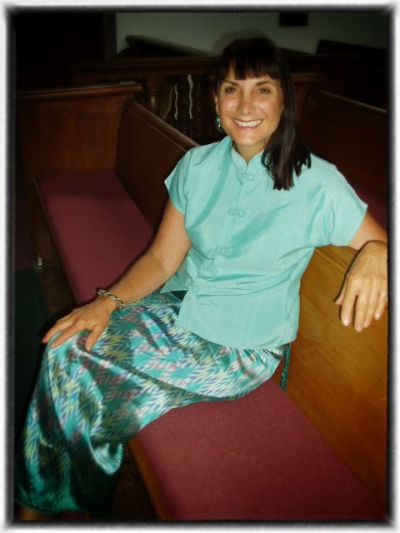 I had been an orphan and spent seven abysmal years in foster homes. When my mother died of cancer, I was only ten. She was 45. It was the worst thing that ever could happen to me, I thought. Unresolved grief walled my heart. For comfort, I turned to my big sister who was as devastated as I. And I looked to my distant, hard working, passionate Ukranian immigrant father for a sense of security. Though he tried to fill my loneliness, he suffered from depression.
I had been an orphan and spent seven abysmal years in foster homes. When my mother died of cancer, I was only ten. She was 45. It was the worst thing that ever could happen to me, I thought. Unresolved grief walled my heart. For comfort, I turned to my big sister who was as devastated as I. And I looked to my distant, hard working, passionate Ukranian immigrant father for a sense of security. Though he tried to fill my loneliness, he suffered from depression.
Two years after my mother died, my father died. I was twelve and alone. Because my sister was separated and planning to divorce, the courts decreed that her’s was a broken home and not a good environment for me. Thus, I was sent to the first foster home. I lost my mother, my father, my home, most of my belongings and close contact with my sister. I was isolated and abandoned.
Somehow, I gathered family photos. As I matured, through hard work (dealing with my own suffering), years of schooling and post-school training, I chose a career in mental health. I found happiness and deep satisfaction as a mother to my daughter.
When my father left Russia in 1915, he was 15 years old. He never saw his family again. I was told he kept a goat in a lot on Prince St., Newark, New Jersey. A noted School of Medicine and Dentistry now stands on that spot. A letter from his mother in 1939 contained a photo of his nephew, and a request to cease communication. At that time, having American family was potentially politically dangerous. The last he heard about them was that they were starving during WWII. When my father died in 1956, he thought they had starved to death or were killed by Nazis.
words + photos by Jolandi Steven
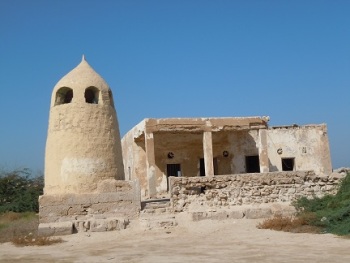 In the pursuit of progress, the past is often overlooked, neglected, discarded or forgotten.
In the pursuit of progress, the past is often overlooked, neglected, discarded or forgotten.
But to me, it holds an allure that is enticing, charming, mesmerizing and utterly seductive. Not so for everyone: When I first mentioned the abandoned village of Al Jazirah Al Hamra on the outskirts of Ras-al-Khaimah in the United Arab Emirates to my husband, he evinced his non-committal with a shrug of his shoulders.
Thanks to Google, I learned that Al Jazirah Al Hamra means “Red Island,” and before the discovery of oil and subsequent land reclamation that linked the old town permanently to the mainland, it was on a peninsula that, with high tide, became an island. The questions puzzling me were: “Why did the people abandon their homes?” “Where did they go?”
CHIAPAS, MEXICO: Maya, Mother Nature, and More.
Discover Chiapas, Mexico, through three unique perspectives. Judith Fein explores Maya ruins, culture, and traditions with archaeologist Yolanda Ruanova, uncovering the ancient and contemporary Maya world. Photographer Paul Ross captures the faces and landscapes of Chiapas. Ellen Barone embarks on a backcountry equestrian adventure with Enduro Ecuestre. Experience history, culture, and adventure in Mexico’s hidden gem.
Discover the Exotic on a Road Trip
“None of your business,” she said. The short, curly, white hair bounced as she shook her head, but the brown eyes smiled in her beautiful, tanned and weathered face. Half Navajo, Suzie (not her real name) has lived in Rio Grand pueblos in New Mexico all her life. We were sitting in a rambling adobe house near the village where she lives with her husband. Grandchildren and daughters dropped in from time to time as we talked. The smell of cedarwood smoke curled around us, and tin-framed pictures of saints glinted on the walls.
by Jess Smith
The ginger-haired boy positioned his freckled face above the school gate, “Hey you, white nigger.”
I gulped a lungful of air and screamed back defiantly, “Go roll with your pigs, farm yard scum.”
He slammed the gate shut, and screeched back, “Rather live in a dung heap than a filthy tent! Tinky vermin, your mother can’t knit, your father kicked a policeman and is lying in the nick (jail).”
I flew at him with fanned fingers and grabbed bunches of red hair. Like tail tied wildcats we scratched, punched and rolled in the dirt and chuck gravel. I knitted my legs around his heaving chest and hissed, “My daddy says your father spends more time on the hillside with the sheep than he does with your ugly mother!”
Teeth clenched, he retorted, “Your mother’s a witch; you’re a goblin, so there!’
Fueled temper blotted all memory of the battle, except for the teacher shouting as he cast me aside like a rag doll, “Bloody uncivilised tinker, go home. You too, boy.”
I limped home from school that day sporting two bruised shins; he was such a big boy with hard capped boots. Layers of pink flesh under my nails and red hair between my swollen fingers proved I managed to hold my own.
 “Mammy,” I cried, “why does every school have a nasty boy who hates us and what’s a nigger and when did we live in tents?”
“Mammy,” I cried, “why does every school have a nasty boy who hates us and what’s a nigger and when did we live in tents?”
The previous month, my beautiful raven-haired mother had given birth to her eighth daughter. Her back was still weak and painfully sore as she bent over a metal bath scrubbing nappies (diapers). Rising slowly, she straitened her spine, inhaled and rested two soapy fists on slender hips. I rushed over and circled her thighs. “Oh mammy. Why is life so awful?”
“Oh dear, not another fight.” She blew onto my tear-sodden eyes and kissed my knuckles.
“Empty headed boy, he’ll never live as rich a life as you. All that waits for him is moaning about the price of cattle food.”
She lifted my chin and smiled. “You share the world with all God’s creatures and strong, powerful warriors from Africa are called niggers but only by ignorant people who don’t know better. Now remember I told you about grandma and grandpa living in tents most of their lives. Tree bark peeling, hazelnut gathering, snaring rabbits and selling the skins put food in our bellies just like you going berry picking in summer and potato lifting in the autumn. I was raised walking behind the horses’ hooves, as was your father. If the tent was erected properly, it was cozy and kept out the worst snow and gales.”
by Paul Ross
Remember when you were a kid and some relative dragged you, with the best of intentions, to an historical “re-creation” because it was fun AND educational!? You don’t remember what you learned -- so much for education. And it was only slightly more fun for you than for the poor souls who suffered through the real thing ... because they were so miserable, they didn’t mind dying at age 19 from enlarged pores while semi-skilled barbers attached leeches to their appendages.
Photo Slide Show by Paul Ross
These glossed-over, sanitized, falsely nostalgic, contemporarily cosmetic pseudo-experiences invariably celebrate a time of exploitation. And the POV romantically, religiously and ideologically chosen is from the lowest rung of the social ladder. The idea may be noble, but you are not.

